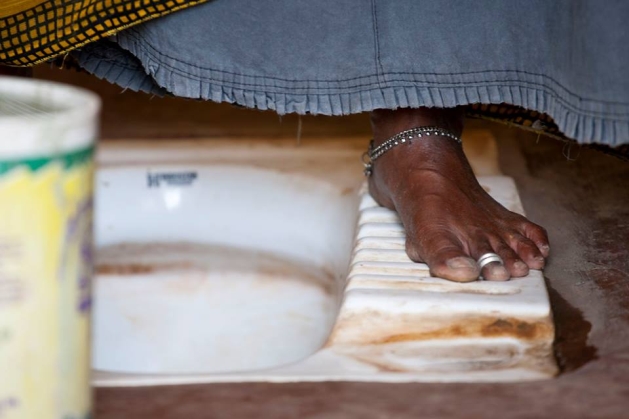
A Dalit woman stands outside a dry toilet located in an upper caste villager’s home in Mainpuri, in the northern Indian state of Uttar Pradesh. Credit: Shai Venkatraman/IPS
MADRID, Nov 14 2022 (IPS) – For those who have it, a toilet is that ‘thing’ in the bathroom, next to the bidet, the hand-washing sink with hot and cold water faucets, and the bathtub.
Given their ‘unprestigious’ function, some billionaires, in particular in the Gulf oil-producer kingdoms, fancy to pose their buttocks on a solid-gold toilet. Once they are there, why not also solid-gold faucets?
Many others prefer a more comfortable use of their toilets, thus endowing them with both automatic heating and flushing. And anyway, being given-for-granted, nobody would give a thought to the high importance of all these ‘things’.
The other side of the coin shows an entirely different picture. A shocking one by the way.
Billions of humans without one
And it is a fact that close to 4 billion people –or about half of the world’s total population of 8 billion– still live without access to a safe toilet and other sanitation facilities.
Nearly a full decade ago, the international community, represented in the United Nations General Assembly, decided to declare 19 November every single year, as a world day to address such a staggering problem.
And year after year, the UN continues to behave ‘politically correct’ by saying that progress and achievements were anyway made, however much would still be to do.
Despite such ‘correctness,’ the UN Secretary-General, António Guterres, stated on the Day that the world is “seriously off track to keep our promise of safe toilets for all by 2030 – a crucial indicator in the 2030 Agenda for Sustainable Development. Investment in sanitation systems is too low and progress remains too slow.”

Photo courtesy: Shelter Associates
The facts
Well, this year’s) provides some shocking facts:
Death of the children: Every day, over 800 children under age five years old die from diarrhoea linked to unsafe water, sanitation and poor hygiene.
Poor sanitation is linked to the transmission of diarrhoeal diseases such as cholera and dysentery, as well as typhoid, intestinal worm infections and polio. It exacerbates stunting and contributes to the spread of antimicrobial resistance.
Globally, 1 in 3 schools do not have adequate toilets, and 23% of schools have no toilets at all. Schools without toilets can cause girls to miss out on their education. Without proper sanitation facilities, many are forced to miss school when they are on their period.
Open defecation: about 900 million people worldwide practice open defecation, meaning they go outside – on the side of the road, in bushes or rubbish heaps. It’s often a matter of where they live: 90% of people who practice open defecation live in rural areas.
Of these, 494 million still defecate in the open, for example in street gutters, behind bushes or into open bodies of water.
Moreover, the lack of sanitation services, just in the year 2020, stood behind the fact that 45% of the household wastewater generated globally was discharged without safe treatment.
Consequently, at least 10% of the world’s population is thought to consume food irrigated by wastewater.

Safely managed sanitation protects groundwater from human waste pollution. Credit: Lova Rabary-Rakontondravony/IPS
The impact on underground water
Should all this not be enough, the 2022 World Toilet Day focuses on another invisible fact: the grave impacts of such a sanitation crisis on groundwater, which is the source of up to 99% of the world’s fresh water.
The 2022 campaign ‘Making the invisible visible’ explores how inadequate sanitation systems spread human waste into rivers, lakes and soil, polluting underground water resources.
However, this problem seems to be invisible. Invisible because it happens underground. Invisible because it happens in the poorest and most marginalised communities.
Groundwater is the world’s most abundant source of freshwater. It supports drinking water supplies, sanitation systems, farming, industry and ecosystems. As climate change worsens and populations grow, groundwater is vital for human survival.
The invisible dangers
The central message of World Toilet Day 2022 is that safely managed sanitation protects groundwater from human waste pollution.
See why:
Safe sanitation protects groundwater. Toilets that are properly located and connected to safely managed sanitation systems, collect, treat and dispose of human waste, and help prevent human waste from spreading into groundwater.
Sanitation must withstand climate change. Toilets and sanitation systems must be built or adapted to cope with extreme weather events, so that services always function and groundwater is protected.
The above shows how those ‘things’ in the bathroom can be life-saving.
Moreover, for those who are obsessed with measuring human suffering in purely money-making terms, it should be enough to know that providing adequate sanitation is a good business: each 1 US dollar invested in it means 5 US dollars saved in health services.